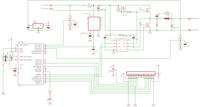Adri67
Junior Member level 2
Hello !
I have a problem understanding how the SR (synchr.rectifier) Q3 functions.
I'm okay with the first uS's after Q1 & Q2 have turned off and Q3 conducts unloading L1 cia C3, i.e. improved job that D1 does.
But what happens then?
The way I understand it is that seeing that the MOSFET is bi-directional when switched on, the device effectively short-circuits the output (and the battery).
Or perhaps that L1 is so large that it keeps supplying current during the entire "on-period" of Q3.
What am I reading wrong or missing?
Thanks in advance

I have a problem understanding how the SR (synchr.rectifier) Q3 functions.
I'm okay with the first uS's after Q1 & Q2 have turned off and Q3 conducts unloading L1 cia C3, i.e. improved job that D1 does.
But what happens then?
The way I understand it is that seeing that the MOSFET is bi-directional when switched on, the device effectively short-circuits the output (and the battery).
Or perhaps that L1 is so large that it keeps supplying current during the entire "on-period" of Q3.
What am I reading wrong or missing?
Thanks in advance
